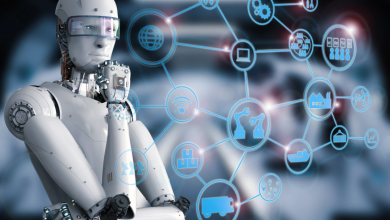The Role of AI in Cyber Security: Safeguarding Digital Identity
In the present progressively computerized world, network protection has turned into a vital concern. With the ascent of digital dangers, for example, hacking, phishing, and ransomware assaults, getting computerized characters and safeguarding touchy data are basic for people, organizations, and state run administrations the same. Man-made consciousness (artificial intelligence) is altering digital protection by giving high level devices and methods to distinguish, forestall, and relieve digital dangers. From continuous danger identification to smart verification frameworks, simulated intelligence is assuming a vital part in protecting computerized characters.
This article will investigate the job of simulated intelligence in digital protection, how it improves customary safeguard components, and the possible difficulties and moral contemplations that accompany coordinating simulated intelligence into network safety procedures.
1. Figuring out Advanced Character and Digital Dangers
Prior to jumping into the job of artificial intelligence in network safety, it’s critical to comprehend what advanced personality is and why it needs assurance. Advanced personality alludes to the web-based portrayal of people, associations, and gadgets. It comprises of individual and hierarchical information, for example, usernames, passwords, email addresses, monetary data, and the sky is the limit from there. In this present reality where a rising number of administrations and exchanges happen web based, safeguarding advanced character is fundamental to keep up with trust, protection, and security.
Digital dangers focusing on computerized character have developed quickly, taking advantage of weaknesses in customary safety efforts like secret word security, encryption, and firewalls. Cybercriminals use strategies, for example, phishing, certification robbery, information breaks, and social designing to acquire unapproved admittance to delicate data. As these dangers develop more modern, conventional digital protection approaches have battled to keep pace, making a squeezing need for simulated intelligence driven arrangements.
2. The Job of simulated intelligence in Network safety
Artificial intelligence is changing digital protection by upgrading danger identification, robotizing reactions, and giving astute safeguards that can adjust to developing digital dangers. This is the way computer based intelligence is assuming a vital part in different parts of digital protection:
a) Constant Danger Discovery and Counteraction
One of the main commitments of simulated intelligence to network protection is its capacity to distinguish dangers progressively. Conventional security frameworks depend on predefined rules and marks to recognize malware or other dubious exercises. Be that as it may, with the fast development of digital dangers, these static techniques are many times lacking in distinguishing new and obscure dangers.
Man-made intelligence, especially through AI (ML) calculations, can dissect tremendous measures of information progressively and recognize peculiarities that could demonstrate a security break. AI models are prepared on huge datasets of organization traffic, client conduct, and known dangers. When prepared, these models can distinguish unusual examples or deviations from customary way of behaving, hailing them as potential digital assaults. Dissimilar to control based frameworks, artificial intelligence fueled discovery frameworks can gain from new information and adjust to arising dangers without manual mediation.
For instance, man-made intelligence can examine network traffic and identify strange examples, for example, unexpected spikes in information moves or unapproved access endeavors from new areas. By recognizing these abnormalities, man-made intelligence can alarm security groups to expected breaks or pernicious exercises before they cause huge harm.
b) Conduct Investigation for Character Verification
Simulated intelligence is upsetting character verification by supplanting static safety efforts, for example, passwords and security questions, with dynamic, conduct based validation frameworks. Customary secret word based security is defenseless against phishing assaults, secret key breaks, and savage power endeavors. Simulated intelligence, notwithstanding, can use social examination to verify clients in light of exceptional, hard to-counterfeit qualities.
Conduct biometrics use man-made intelligence to examine examples like composing speed, mouse developments, and even the way that clients associate with their gadgets. These social qualities are one of a kind to every person and hard for assailants to recreate. Computer based intelligence controlled frameworks can consistently screen these ways of behaving to guarantee that the individual connecting with the framework is who they guarantee to be. On the off chance that the conduct digresses from the standard, the framework can signal the collaboration as dubious and require extra verification steps, for example, multifaceted validation (MFA) or biometric examines.
This versatile way to deal with character confirmation safeguards advanced personalities from account takeovers and unapproved access, particularly in situations where customary passwords have been compromised.
c) Prescient Investigation for Danger Hunting
Man-made intelligence’s prescient capacities are being utilized to proactively distinguish potential digital dangers before they manifest into all out assaults. Prescient danger hunting implies dissecting verifiable information to expect future digital dangers and weaknesses. Artificial intelligence models can filter through enormous datasets, including logs, danger knowledge takes care of, and verifiable digital occurrences, to distinguish designs that demonstrate a possible assault.
For instance, computer based intelligence can break down the strategies, methods, and systems (TTPs) utilized by cybercriminals in past assaults and anticipate when comparative procedures may be utilized once more. Security groups can then make a preplanned move, like fixing weaknesses or supporting safeguards fully expecting an assault.
Man-made intelligence driven prescient examination is especially helpful in distinguishing zero-day weaknesses — already obscure security imperfections that can be taken advantage of by programmers. By distinguishing weaknesses before they are well known, simulated intelligence assists associations with remaining one stride in front of cybercriminals and forestall breaks.
d) Robotization of Occurrence Reaction
Simulated intelligence is additionally changing the way in which associations answer digital episodes. Generally, occurrence reaction requires human mediation, which can postpone activity and increment the harm brought about by a digital assault. Simulated intelligence controlled frameworks can mechanize numerous parts of occurrence reaction, diminishing the time it takes to recognize and alleviate dangers.
For example, artificial intelligence driven security data and occasion the executives (SIEM) frameworks can consequently isolate contaminated gadgets, block dubious IP addresses, or limit admittance to compromised accounts. These computerized reactions forestall the spread of malware and decrease the general effect of an assault.
Besides, simulated intelligence frameworks can persistently screen and investigate the adequacy of their reactions, gaining from every occurrence to work on future reactions. This ability is particularly significant in huge associations where security groups are much of the time overpowered by the sheer volume of cautions and occurrences that require consideration.
e) Improving Information Encryption and Security
Computer based intelligence is likewise being utilized to improve information encryption and security assurance. Conventional encryption strategies depend on fixed calculations that can some of the time be defenseless against animal power assaults. Artificial intelligence is assisting with growing more complex encryption calculations that can adjust to expected dangers continuously.
For instance, simulated intelligence can naturally change encryption levels in light of the awareness of the information being sent, giving an additional layer of security where required. Also, computer based intelligence can recognize and forestall unapproved endeavors to unscramble delicate information, guaranteeing that main approved parties approach safeguarded data.
In the domain of security assurance, computer based intelligence is being utilized to distinguish and moderate potential protection infringement, like unapproved sharing of individual information or the utilization of delicate data without assent. Computer based intelligence driven security observing apparatuses can dissect how individual information is being utilized and guarantee consistence with guidelines like the Overall Information Assurance Guideline (GDPR) and the California Shopper Protection Act (CCPA).
3. Challenges and Moral Contemplations of simulated intelligence in Digital protection
While simulated intelligence offers amazing assets for improving network protection, its mix into security systems additionally presents a few difficulties and moral contemplations.
a) Predisposition in simulated intelligence Calculations
One of the main issues with artificial intelligence in digital protection is the potential for predisposition in AI calculations. Artificial intelligence models are just however great as the information they may be prepared on. In the event that the preparation information is deficient or one-sided, the man-made intelligence framework might neglect to recognize particular kinds of dangers or excessively banner genuine activities as dubious. This could bring about over-policing of specific clients or frameworks, prompting misleading up-sides and adverse consequences on people or organizations.
b) Antagonistic Assaults on artificial intelligence Frameworks
Cybercriminals are continually tracking down better approaches to sidestep security frameworks, and man-made intelligence isn’t safe to assault. In an ill-disposed assault, programmers control the contributions of a simulated intelligence model to fool it into going with wrong choices. For instance, an assailant could change the information used to prepare an artificial intelligence based malware recognition framework, making it ignore malignant code. These ill-disposed assaults represent a huge test to the security of simulated intelligence driven frameworks.
c) artificial intelligence Driven Reconnaissance and Security Concerns
The utilization of artificial intelligence in reconnaissance and observing has raised worries about protection and common freedoms. Simulated intelligence fueled frameworks can dissect huge measures of information, including individual correspondences, ways of behaving, and area information, to identify possible dangers. While this capacity is helpful for upgrading security, it likewise brings up issues about the harmony among security and individual protection. Policymakers and associations should cautiously consider the moral ramifications of man-made intelligence driven observation to guarantee that these advancements are not used to encroach on individual flexibilities.
d) Reliance on man-made intelligence Frameworks
As associations progressively depend on simulated intelligence to oversee network safety, there is a gamble of over-reliance on these frameworks. While man-made intelligence can improve safety efforts, it isn’t trustworthy. Over-dependence on computer based intelligence could prompt complacenc
Conclusion
Artificial intelligence innovation is reforming the field of network safety, giving incredible assets to danger identification, episode reaction, and character assurance. Overwhelmingly of information, gaining from designs, and robotizing security processes, artificial intelligence upgrades the capacity of associations to safeguard computerized characters progressively. In any case, as computer based intelligence turns out to be all the more profoundly coordinated into digital protection methodologies, tending to the difficulties and moral contemplations that accompany it is fundamental. Thusly, we can guarantee that man-made intelligence stays a power for good in the battle against cybercrime, assisting with shielding



